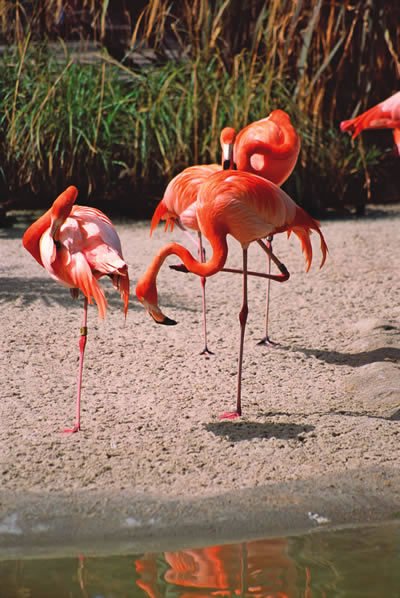Flamingo
The flamingo is known for its bright pink feathers and uniquely downcurved black-tipped bill, which is adapted to filter feeding.

Created on Day 5
Design
The flamingo sucks water and mud into its beak with its unique tongue and then pumps the water out the sides of its mouth. Small creatures are captured in the flamingo’s filtering system of tiny plates. Flamingos feed in a manner similar to that of baleen whales.
Features
- The flamingo is known for its bright pink feathers and uniquely downcurved black-tipped bill, which is adapted to filter feeding.
- The flamingo is quite unmistakable, with its remarkably long legs and neck.
Fun Facts
- The flamingo’s pink color comes from the food that it eats.
- The flamingo uses different displays, including head-flagging, wing saluting, twist-preening, and marching.
- All five species of flamingos have black flight feathers.
- Flamingos can fly up to 35 mph (60 km/h).
- Flocks tend to fly in lines or in V-formation, like geese and cranes.
CLASS: Aves (birds)
ORDER: Phoenicopteriformes (flamingos)
FAMILY: Phoenicopteridae (flamingos)
GENUS/SPECIES: Phoenicopterus (six species)
Size: About 3–5 ft (1–1.6 m) tall; wingspan 3–5 ft (1–1.6 m)
Weight: Between 3 and 9 lbs (1.4–4 kg)
Diet: Algae, shrimp, and other small aquatic creatures
Habitat: Africa, Asia, the Americas, and Europe in shallow lakes or lagoons
Aquarium Guide
With fun facts about more than 100 animals, this long-awaited Aquarium Guide includes beautiful pictures and reveals the incredible facts and design features that point to our amazing Creator. This handy size guide is excellent for school field trips and family trips to your favorite aquarium!
Browse Kids Book- © 2024 Answers in Genesis
- Privacy Policy
- Contact
- About

